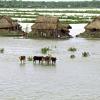
The FRMC was created by the Zurich Flood Resilience Alliance in 2013 and is an innovation in community flood resilience theory and practice. It allows users to generate evidence about the ways in which a given area or community is already resilient to floods, as well as providing a guide to further develop this resilience
The Zurich Flood Resilience Alliance focuses on building flood resilience. Flood prevention is cost-effective, but nearly 87 per cent of disaster-related aid spending goes into emergency response, reconstruction and rehabilitation, and only 13 per cent towards reducing and managing risks before they became disasters. That is why, in 2013, a multi-organizational partnership – the Zurich Flood Resilience Alliance – was created to enhance community flood resilience.
The Flood Resilience Measurement for Communities (FRMC) comprises two parts: the Alliance’s framework for measuring community flood resilience, and an associated tool for implementing the framework in practice.
The FRMC framework
The framework, also called the 5C-4R framework, combines 44 indicators – so called sources of resilience, on five complementary ‘capitals’ (5C) as well as four properties derived from resilient system-thinking (4R), that can help people on their development path and also provide capacity to withstand and respond to shocks.
The 5Cs comprise human, social, physical, financial and natural capital. The 5Cs provide greater richness of data about a community’s sources of resilience than any single metric such as average income.
Each capital group contains a set of generic and discrete sources of resilience (which can be thought of as sub-indicators). Across the 5Cs there are 44 sources of resilience, each specifically defined. Sources of resilience are grouped under the four headings of robustness (ability to withstand a shock), redundancy (functional diversity), resourcefulness (ability to mobilize when threatened), and rapidity (ability to contain losses and recover in a timely manner).
This ‘systems thinking’ approach takes into account the assets, interactions and interconnections at community level, and provides consistency when it comes to identifying and testing sources of resilience.
The FRMC tool
The second component of the FRMC – the tool – is a practical hybrid software application comprising an online web-based platform for setting up and analyzing the process and a smartphone- or tablet-based app that can be used offline in the field for data collection.
To measure each source of resilience in a given community, data can be collected in four different ways (i.e. household surveys, key informant interviews, focus group discussions, and the use of secondary sources) according to context and need.
After data is collected on the app, it is uploaded to the web application. Assessors grade each of the 44 sources of resilience on an A–D scale (A being best practice, D being poor). Trained assessors compare source definitions with the collected data, drawing on their experience, training, the user manual and related guidance.
The 44 grades between A and D awarded to each community are then aggregated in different ways for analysis. Aggregations, or “lenses”, by which resilience can be viewed include the 5Cs and the 4Rs. Further lenses are the seven themes by which questions are sequenced thematically (such as healthcare, education, livelihoods etc.), the five steps of the Disaster Risk Management (DRM) cycle (preparedness, response, recovery, prospective risk reduction, and corrective risk reduction) and many more.


